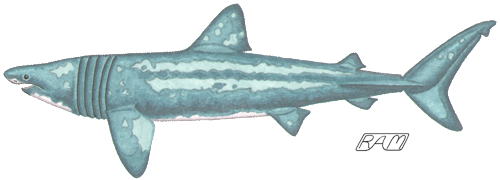A Curious Basker

Basking Shark (Cetorhinus maximus)
Responding to a question about a basking shark being attracted to his boat and the writer's speculation that it might have appeared as a sexy female basker to a near-sighted male, I wrote:
In my experience, Basking Sharks (Cetorhinus maximus) are at best indifferent and at worst frustratingly shy of boats — at least from the perspective of one who would get close to them.
It seems unlikely that your vessel was mistaken for a conspecific by a horny Basking Shark (Based on the structure of the Basking Shark brain and this species' observed behavior in the wild, Baskers are not the brightest of sharks — but they're not *that* stupid!). I would speculate that your boat-approaching Baskers were motivated by either exploratory feeding or pure curiosity.
It is unknown how Basking Sharks and other planktivorous elasmobranchs actually locate patches of plankton. Given their well-developed olfactory bulbs, it seems likely that Basking Sharks would locate planktonic prey by scent, possibly following increases in the concentration gradient of a smelly chemical called dimethyl sulfide (DMS). DMS is released in abundance by copepods and other zooplankton during feeding on phytoplankton, and this compound is already known to be an olfactory foraging cue used by calanoid (antenna-swimming) copepods and procelariid (tube-nosed) seabirds, so the notion that the Basker also uses this chemical cue is not without precedent. DMS may be concentrated by the propwash or wake of a boat, or actually adhere electrostatically to the hull itself, thereby stimulating the Baskers' interest in your vessel.
Alternatively, the Baskers in question may simply have been curious. The head-up orientation you describe (see your original post) is an uncharacteristic feeding posture for this species, and thus may indicate a visual inspection of your hull. The eyes of a Basking Shark are proportionately small but apparently well-formed and fully functional; it seems likely that schooling behavior in these huge, social sharks may be at least partially visually mediated (possibly responding to contrast between the pale streaks & blotches and dark background color of this species back and flanks). Thus, any unusual contrast or shape may have inspired a couple of intrepid Baskers to check out your hull.
Yet another possibility is that zinc-copper or other metallic antioxidation plates (if any) on your hull may have generated an attractive or interesting electrical field. Such fields have apparently elicited a similar 'Tail Stand' behavior in the closely-related White Shark (Carcharodon carcharias) — see Tricas & McCosker 1984 [Proc.Calif.Acad.Sci., 43 (14): 221-238] for a photo of this behavior and further details. It is unknown whether electroreception plays an important role in Basking Shark feeding or social behavior, but therein lies some interesting possibilities.
Cheers,
— R. Aidan Martin
Posted to SHARK-L May 3, 1999
